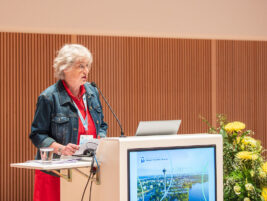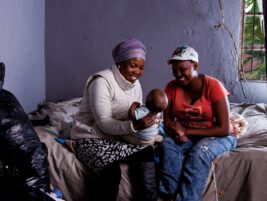Prepared by the FrameWorks Institute with funding from the Center on the Developing Child at Harvard University and reprinted here with permission from the FrameWorks Institute
Introduction
The research presented here was conducted by the FrameWorks Institute and sponsored by the Center on the Developing Child at Harvard University. This report is part of a larger project that aims to translate the science of early child development (ECD) into the field of international development. The guiding question of this larger project is: How can the science of early child development be communicated to increase science-understanding and create better alignment between scientific research and international development programs and policy?
The following report presents results from the first phase of this larger effort. In the report, FrameWorks analyzes data from a series of cognitive interviews in order to identify and describe the implicit assumptions, norms and patterns of understanding that leaders in the field of international development employ in thinking about their own work, children’s issues generally and ECD more specifically. These assumptions can be seen as the cognitive “filters” through which key science messages will be interpreted. The analysis of these “filters,” along with other empirical research, will inform recommendations designed to increase the accessibility of this science to these international development leaders, as they make programmatic decisions for their respective organizations and shape the field more generally.
FrameWorks approached this work through a series of in-depth interviews conducted with a sample of organizational leaders in the field of international development. The focus on leaders was motivated by the project’s guiding question: how to create better alignment between the work of international development organizations and the science of ECD. We believed that focusing on leaders of the field would be critical to creating the significant changes required to increase access and understanding of key science messages of ECD.1 An important subsequent phase of research will explore the similarities and differences between the patterns of thinking documented in this report and those employed more broadly by members of this field.
Recruiting leaders from international aid organizations poses specific challenges to the way that FrameWorks typically analyzes cultural norms and understandings. FrameWorks adopts a position that many of the norms and assumptions that guide understanding are implicit — that they operate at a cognitive level somewhere below that of the explicit and volitional.2
FrameWorks documents these shared implicit constructs as they are brought to bear in reasoning among members of a common culture. FrameWorks has typically studied how Americans’ or Canadians’ understandings are informed by such shared sets of implicit assumptions — assumptions that can be bundled into patterned collections of propositions and implicit understandings referred to in the literature as “cultural models.”3
The basic notion is that individuals, irrespective of demographic or ideological variations, share and employ a common set of underlying mental models about the world that stem from the experiences they share as members of a common cultural group. It is this larger national sense of culture — as the beliefs, norms and understandings that are shared across and shaped by individuals exposed to a common national media and public discourse — that typically constitutes the focus of our research.
The research described here uses the concept and theory of cultural models slightly differently – probing a different level of “culture” for shared implicit understandings. In the analysis discussed here, the sample is based on a shared membership in a professional field.4 We analyze the data to determine how individuals across this sample make common assumptions as they talk and think. We contend to have found a set of cognitive constructs that function in the same way as “cultural” models, but that are shared by a group of people based on professional expertise rather than a common national culture. In short, we still focus on documenting cultural models, but the “culture” is of a different sort than that which normally constitutes our focus.
FrameWorks’ approach is grounded in the notion that, in order to translate the set of ECD science messages effectively, communicators must understand the default patterns of reasoning used to make sense of the issue. Only when they understand “what they are up against” can they be prescriptively strategic and effective. Knowing how the leaders of this field employ a common set of meaning-making devices allows us to figure out the most effective and efficient ways of fitting the science of early child development into the norms of the field. It also allows us, in some cases, to strategically build on features of this understanding in order to make space for the science of ECD and related policy recommendations. The end goal is to infuse this field with a scientifically faithful understanding of ECD that helps set the agenda and allocate resources towards policies and programs that are in line with the implications of the science of ECD. In this way, laying out the common features of the way these international development organization leaders understand children’s issues and early child development creates a map that can be used to craft strategic translations of the science of ECD.
Executive summary
Leaders of the field of international development share critical understandings and assumptions that guide the way they think about their own field of work, children’s issues in general and early child development.
- A widely shared hierarchy of needs model poses a major obstacle to communicating the science of ECD, and of shifting resources in the direction of those policies and programs that the science suggests are effective. According to this model, the field’s work on children’s issues is cognitively represented as a hierarchy of sequential tiers. The key to the model is that the concerns comprising foundational levels of the hierarchy must be satisfied before issues on subsequent levels may be addressed. Issues pertaining to child survival constitute the base of the hierarchy and issues of child development represent some level above this foundation. Putting these spatial and content assumptions together, informants assumed that issues of child survival must be satisfactorily dealt with before work on development can be prioritized. Communicators must be aware that the hierarchy of needs model allows ECD to be acknowledged as “important,” but only prudent to address after, as one informant put it, “we’ve taken care of child survival.”
- Leaders applied a zero-sum model of discrete and competing sectors comprised of health, education and justice/rights in conceptualizing the field of international child advocacy. As ECD does not comprise a sector, this assumption suggests that communications that talk directly about the importance of ECD will be difficult to fit into the existing structure of the field. The sectors are perceived to be discrete and siloed. This model offers both opportunities and challenges for communicating ECD as a process which underlies all aspects of child well-being, without being perceived as competing with any established sector.
- Leaders of the field think of their work as investments. This metaphorical model was comprised of a set of more specific assumptions: that resources are limited, that the goal is to realize the largest return possible, that returns must be visible and measurable, that they must occur in relatively close temporal proximity to the investment, and that returns must be significant. The investment model presents a particular challenge for translating the science of ECD, which emphasizes the long-term trajectory of effects that begin in childhood.
- A developmental perspective may run counter to a commonly held children are people too model, closely associated with a rights orientation. This perspective may make some of the science messages — about critical developmental periods, for instance, or the importance of developmentally appropriate interventions — difficult to incorporate into existing perspectives.
- A tendency to focus on the nuclear family model limits broader definitions of responsibility and recruitment of additional adult actors in child rearing. The representation of “family” as “nuclear family” ran across the majority of our interviews. Even when informants knew that there were other actors and factors engaged, there was a tendency to focus in on the child in the context of a two-parent household and to evaluate that child’s risk in light of threats to that model. This common mental model of “family” may be problematic in light of the fact that many of the contexts in which the science of development will likely be applied are not characterized by familial structures that approximate this mental model. In short, communicating about different structures and ideas of “family” will require expanding, modifying or perhaps building a new working model of “family.”
- A set of core systemic factors — including education, the economy and the health infrastructure — were perceived as having consistent wide-ranging and diverse effects on child outcomes. This branching-effect model of causality structured an understanding that differentiated between symptoms and root causes, with the best investments in child outcomes addressing the latter. Core issues were, therefore, systemic by definition. This model offers great potential for linking ECD into the causal chains that link interventions to outcomes.
- Leaders in the field of child survival evinced a surprisingly thin understanding of the process of development. While generally conversational with the idea of ECD, they quickly drew a blank about key science tenets. Once the conversation went beyond “early matters,” “supportive relationships are key” and “having a big payoff down the line,” the science of ECD was largely not accessible. Relatedly, many informants also thought about ECD as a “natural” process that “just happens.” This assumption supported views that development occurs optimally when interventions secure the basic safety of a child, and then stand back to let development run its course. In addition, the assumed “naturalness” of the process allowed informants to disengage from thinking actively about how development happens. This suggests not only that attempts to translate the science into this field have yet to be successful in structuring understandings of ECD, but also that there is relatively unfettered cognitive space on this issue for strategic communications to build such process understandings.
- ECD was understood as part of everything, but nothing on its own. In other words, ECD was seen as being part of all the field’s sectors but, at the same time, not being its own stand-alone concept. The acknowledgement of its shared centrality may facilitate the embedding of ECD in other topical areas — a tactical strategy that avoids running up against the zero-sum model mentioned above.
- Leaders tended to take a deterministic approach to development. Once the process of development has been perturbed in some way, they said, there is nothing that can be done. A well-documented assumption in past FrameWorks research, this damage done is damage done model offers communicators an opportunity to introduce the science of neuroplasticity and to demonstrate how interventions that are grounded in developmental science can change the developmental trajectory.
- Assuring positive development was understood to rely most centrally on protecting and finding ways to insulate children from their surrounding environments. This assumption creates an understanding of the relationship between children and contexts that makes it hard to see attempts to encourage positive interactions between children and their environments as effective interventions. This, in turn, sets up the nuclear family as protector in opposition to everyone/everything else as the locus of the threats. From a developmental perspective, it limits the range of supportive experiences and contexts that come to mind, and solidifies the hierarchy of needs model described above.
- Physical growth and health are the “what” that develops during development. This explains the dominant focus among our informants on nutritional programs as the silver bullet intervention. It also demonstrates the importance of developing appreciation for ECD as a process separate and apart from either health or education, but one that influences both.
- The family bubble model of development predominated. ECD was also seen as the narrow provenance of the family. At times, this assumption crowded out other factors of importance and led to relatively narrow views, especially in comparison with some of the more general models employed by our informants, of the determinants of child development.
The mental models documented here show that, in many ways, existing research on how Americans and Canadians think about ECD is consonant with the way that international development leaders think about the concept. However, this analysis also shows a unique set of mental models that these leaders employ. The documentation of these unique models, primarily the hierarchy of needs model, as well as understandings about how the field of international development is organized, suggest specific strategies for communicating the science of ECD and its policy implications. In general, we suggest avoiding the hierarchy of needs and zero-sum models, all the while embedding ECD into the existing troika of appreciated issues — health, education and, to a lesser degree, rights — and into the already acknowledged systemic forces — economy, education and health infrastructure — that are seen to shape child outcomes.
References
1 Sashkin, M., Morris, W., & Horst, L. (1973). A comparison of social and organizational change models: Information flow and data use processes. Psychological Review, Vol 80(6), 510-526.
Valente, T., Pumpuang, P. (2007). Health education behavior the official publication of the Society for Public Health Education. Health Education and Behavior, 34, 6, 881-896.
2 Quinn, N., & Holland, D. (1987). Culture and cognition. In D. Holland & N. Quinn (Eds.), Cultural models in language and thought (pp. 3-40). Cambridge, England: Cambridge University Press.
3 D’Andrade, R. (1984). Cultural meaning systems. In R. Shweder & R. Levine (Eds.), Culture theory: Essays on mind, self, and emotion. Cambridge, England: Cambridge University Press.
Shore, B. (1996). Culture in mind: Cognition, culture, and the problem of meaning. New York, NY: Oxford University Press.
4 Chi, M.T.H., Glaser, R., & Farr, M.J. (1988). The nature of expertise. Mahwah, NJ: Lawrence Erlbaum Associates.
Ericsson, K.A., & Smith, J. (1991). Toward a general theory of expertise: Prospects and limits. New York, NY: Cambridge University Press.
(WWW.WAIMH.org to read the full article: Kendall- Taylor, N., & and Baran, M. (2011). Finding a place for early child development in the hierarchy of needs. Washington, DC: FrameWorks Institute.)
Finding a Place for Early Child Development in the Hierarchy of Needs (Exerpts)
Authors
Kendall-Taylor, Nathaniel,
Vice President for Research,
FrameWorks Institute,
Baran, Michael,
Senior Researcher,
FrameWorks Institute),
United States








